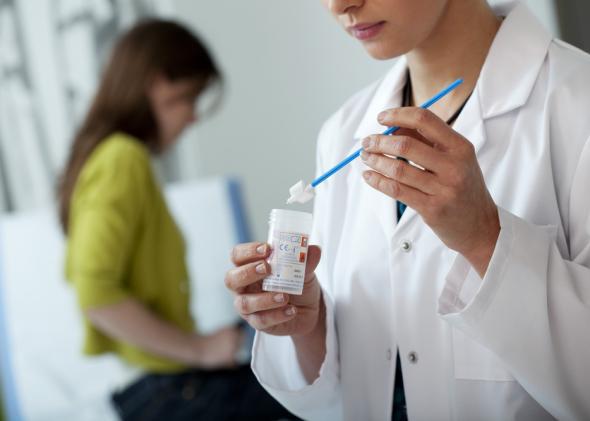The Food and Drug Administration recently signed off on a new approach to preventing cervical cancer in women. Instead of the Pap test, where doctors look for abnormal cells on the cervix that might turn into cancer, some doctors are instead testing women for HPV, since most types of cervical cancer develop from persistent HPV virus in the cervix. But this new method of monitoring patients for possible cervical cancer has been subject to a lot of controversy, as NPR reports. Since a lot of cases of HPV never develop into abnormal cells, much less cancer, the fear is that broad testing of the virus will lead to a lot of unnecessary follow-up tests for women who aren’t on the path to developing cervical cancer:
“Like a cold virus, everyone gets it,” says Susan Wood, a women’s health policy analyst at George Washington University. “It comes and it goes. It’s only if the virus happens to stay around for a period of years that it is associated with the precancerous conditions which — if not treated — could go on to become cancer.”
So, screening everyone for the virus will end up scaring a lot of women for no reason, Wood says. In addition, it could lead to many women going on to get unnecessary follow-up tests, including a procedure known as a colposcopy.
Right now, a colposcopy is usually only administered after you’ve had a couple of Pap tests in a row that show abnormal cells, but the fear is that now doctors will go straight from a positive HPV test to a colposcopy—which might even involve cervical biopsy, which can be very painful and may raise the risk of preterm birth for women who’ve endured it. There’s a legitimate reason to think this is overkill. As Wood noted, most HPV infections are harmless and temporary, and the body clears them out on its own long before abnormal cells have a chance to form. That’s why a lot of doctors prefer to wait to see if abnormal cells develop first, which is what the Pap looks for, before moving on to more invasive testing.
There’s another downside to testing for HPV directly instead of looking for abnormal cells with the Pap test. Even though HPV is common and, yes, you probably have had it or have it right now, it’s still a sexually transmitted infection. There’s still a ton of wholly unnecessary shame and stigma attached to having an STI, and many people who are diagnosed with one buy into the myth that they are now gross and ruined for life. This reaction, euphemistically called “adverse psychological effects” by the Centers for Disease Control and Prevention, helps explain why doctors usually don’t test for herpes, either. (Most cases of herpes have no serious negative health impacts, and when they do, you’ll know you have herpes from the painful sores on your genitals, rendering testing unnecessary.) Ideally, people would respond positively to the message that having an STI makes you “average” instead of “dirty,” but it’s understandable that completely reversing a lifetime of social stigma is more than can be accomplished in one doctor’s visit. Since most HPV clears out on its own without any symptoms whatsoever, it might not be worth giving people a positive HPV test without knowing for sure if it’s ever going to create problems. (All this should serve as a reminder of the importance of making sure both girls and boys get the full rounds of HPV vaccination, which can prevent a lot of these problems in the first place.)
The important thing to do is talk to your doctor about what options are best for you. But the combination of fears over too much testing and fears of increasing unnecessary psychological drama attendant to having an STI are a good enough reason for plenty of doctors to stick with the Pap. Plus, the HPV route doesn’t improve the patient experience. After all, both tests require putting your feet in stirrups and being instructed to “scoot down the table toward me.”
